
Vortex Ranger 1000 Rangefinder
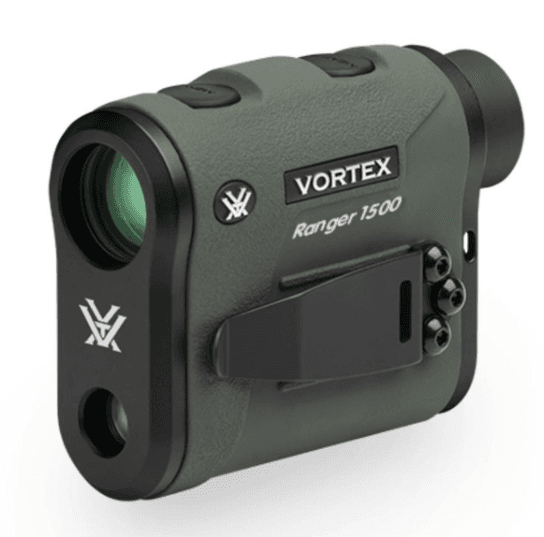
THE RANGER 1000 RANGEFINDER
The Vortex Ranger 1000 is an extremely effective angle compensated laser rangefinder intended for both archer and
rifle shooter. Using the primary HCD (Horizontal Component Distance) mode, the Ranger 1000 provides the key angle compensated range information required by the vast majority of rifle and bow shooters in a simple, quick to read display.
The Ranger 1000 also provides LOS (Line of Sight) mode and Scan feature along with adjustments for reading in yards or meters and setting the brightness of the display.
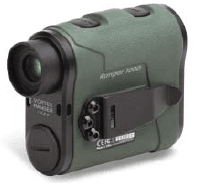
Please be sure to read entire manual prior to using the Ranger 1000.
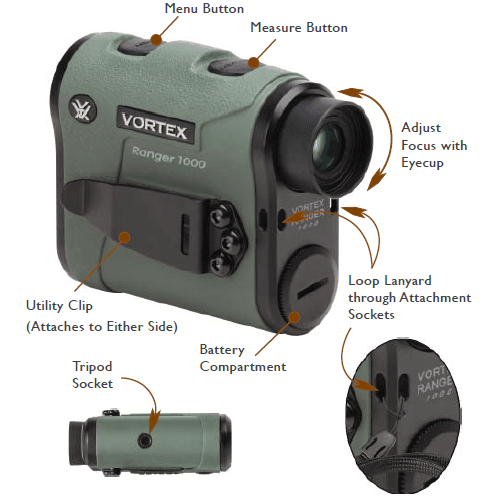
BASIC OPERATION
Install Battery
Open the battery compartment and install the CR2 battery included with the Ranger 1000.
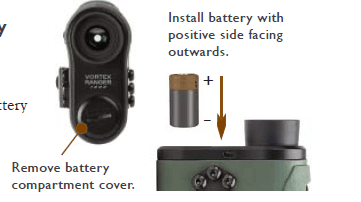
Power Up
With the battery installed, the Ranger 1000 is in a Ready Condition—the normal power-off condition when not ranging. To power up the Ranger 1000 from Ready Condition and prepare for ranging, press and release the Measure button. The HCD or LOS ranging screen will display. The Ranger 1000 will power down automatically after ten seconds of non-use.
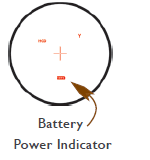
Focus
Turn the eyecup in or out until image is sharp.
Mode Selection
Ranger is factory set to HCD mode, yard, and medium brightness. For most users, these will be the preferred settings. To change modes, after the Ranger is powered up activate the Mode Selection by pressing and holding the Menu button for at least four seconds. This must be done when the crosshair is not displayed on the screen. Once the Mode Selection screen displays, release the button.
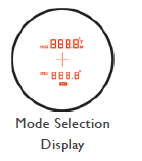
As you progress through Mode Selection, you may exit at any time and save your settings by pressing and holding the Menu button for at least four seconds—the Ranger will then return to power-up condition.
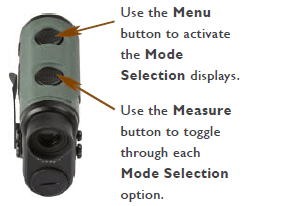
Set and Save Mode Selections in 3 Steps
Step 1 — Choose between the HCD and LOS Modes
After activating the Mode Selection, press the Measure button to toggle between the HCD and LOS displays. Press the Menu button to save your desired choice and move to the Yards/Meters selection screen.
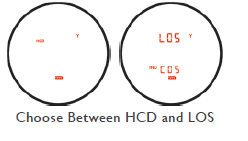
Step 2 — Choose between Yards and Meters Display
Press the Measure button to toggle between the Yards and Meters display. Press the Menu button to save your desired choice and move to the Brightness selection screen.
 Set and Save Mode Selections in 3 Steps
Set and Save Mode Selections in 3 Steps
Step 3 — Choose the Brightness Setting
The Ranger 1000 provides three illumination settings. Press the Measure button to toggle through the three Brightness settings. Press the Menu button to save your desired setting and move back to HCD/LOS selection screen.
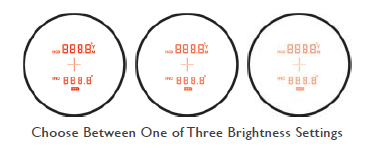
To exit Mode Selection and save settings, press and hold the Menu button for four seconds. Settings will also save when Ranger powers down automatically.
Ranging
With the Ranger 1000 powered up, activate Ranging by pressing and releasing the Measure button—a crosshair will appear in the display. Position the crosshair on the target object and press and release the Measure button again to get the distance measurement. If the laser is not able to range due to the reflectivity of the target, you will see a display similar to that shown here. To range a new target, simply re-aim and press the Measure button again.
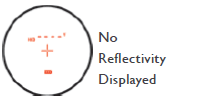
Scan Ranging
With the Ranger powered up, activate Scan Ranging by pressing and holding the Measure button down. A blinking crosshair indicates Scan Ranging is activated. By keeping the button depressed, the Ranger will now continuously measure distance as you pan the crosshair back and forth across target objects. Releasing Measure button will return laser to the Power Up Condition.
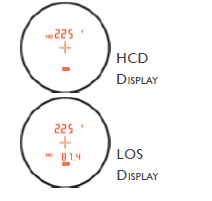
RANGING MODE EXPLANATIONS
The Ranger 1000 provides two range modes: HCD (Horizontal Component Distance) and LOS (Line of Sight). Both modes offer a Scan feature.
HCD Mode
The Ranger 1000’s HCD range display is intended to be the primary mode—used for most all rifle and archery shooting conditions. The yardage number displayed is the critical horizontal component distance.
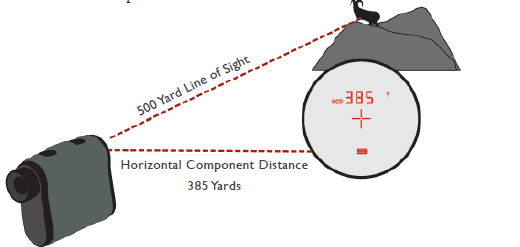
Using the HCD Mode
Use the HCD range mode in the following situations:
- Rifle shooting on level ground at any range.
- Rifle shooting out to ranges of 800 yards with mild slopes (less than 15 degrees).
- Rifle shooting out to ranges of 400 yards with moderate slopes (15 to 30 degrees).
- For all archery shooting.
The displayed HCD yardage number is corrected for shot angle and needs no extra user input; shooters simply use the appropriate level ground bullet drop and wind adjustment for the range displayed and shoot. Archers use the appropriate level ground sight pin for the range displayed and shoot.
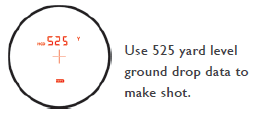
LOS Mode
The Ranger 1000’s LOS (Line of Sight) mode is specialized for rifle shooters who are using slope correcting ballistic drop data cards, ballistic cell phone applications, or PDAs with ballistic programs and who are shooting at distances beyond 500 yards and with slopes greater than 15 degrees (INC readings of 97 or less). Most shooters and archers will not need to use LOS mode.

The range number displayed in LOS mode is the actual line of sight range with no ballistic correction for slope. Most of the commonly used ballistic devices can provide independent slope correction for bullet drop data and require actual line of sight range input. Using the LOS range when calculating bullet wind drifts under these steep slope/long range conditions will provide a higher degree of accuracy than using the HCD range.
To use, simply input the LOS range number into the electronic device or use the LOS range when referencing ballistic drop cards with slope correction.
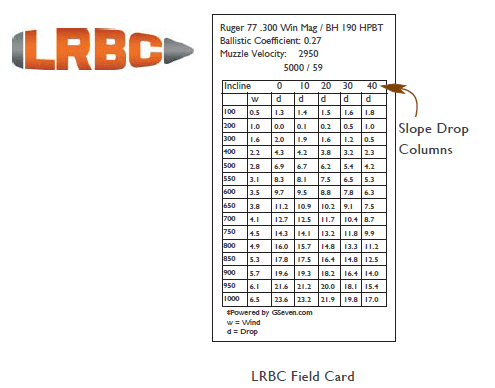
You can generate your own slope-correcting drop data card for your favorite rifle and load. Go to the free Long Range Ballistic Calculator (LRBC) on vortexoptics.com.
LOS Mode – Using the INC Number
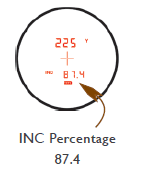
When in LOS mode, an additional number is displayed below the yardage number. This number is an incline (INC) percentage correction number based on angle cosine. If the ballistic program, cellphone application, or drop data card being used to calculate bullet drop does not correct drop data for slope angle, the INC number can be used to adjust bullet drop data—compensating this data for slope angle.
To do this, shooters will need to reference their level ground bullet drop data for the LOS range displayed, and then multiply that drop data number by the incline percentage number (INC) to get the actual holdover for the angled shot.
Level Ground Drop Data x INC Percentage = Sloped Ground Drop Data
A two-sided (MOA or MRAD) Field Reference Card to help with these calculations is included with the Ranger 1000. Due to space limitations on the card, some INC Readings and Drop Data increments will fall between the listed increments—some interpolation may be required.
Using the INC drop data adjustment technique will provide acceptable hunting accuracy at these ranges:
- Out to 900 yards with slopes less than 30 degrees (INC reading greater than 87).
- Out to 500 yards with slopes in excess of 30 degrees (INC reading less than 87).
For demanding shooters, this technique provides a higher degree of accuracy for long distance/steep slope shots than simply using the HCD range and applicable bullet drop number.
Reading the Slope Angle
If an actual slope angle in degrees is desired, use the included Ranger 1000 Field Reference Card to cross reference INC readings to slope angles. Slope degrees are listed on the bottom of the card.
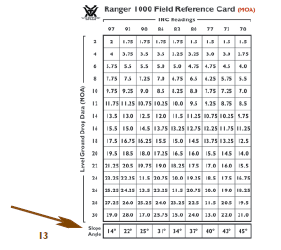
Using the INC
LOS/INC Drop Data Adjustment Technique Example
You have a shot at a ram on a ledge. In LOS mode, you range him at 600 yards with an INC reading of 93 (22 degree slope). You know the bullet in your .300 WinMag cartridge will drop 10 MOA at 600 yards on level ground. To compensate for this angled shot, use the formula below or consult your Field Reference Card.
Example: 10 MOA x 93% (.93) = 9 1/4 MOA
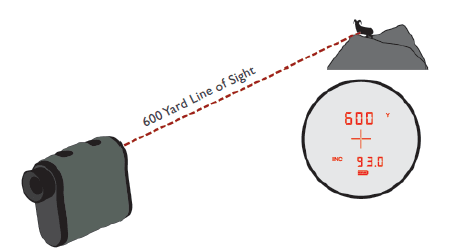
To make this angled 600 yard shot, use a drop adjust of 9 1/4 MOA.
Scan Feature
The Scan feature can be used to range moving targets or help range smaller targets on uniform backgrounds in either HCD or LOS modes. Once powered up, press and hold the Measure button and scan laser back and forth, watching for changes in the yardage number as crosshairs move across the target object. A blinking crosshair indicates Scan Ranging is activated.
Scanning to get range
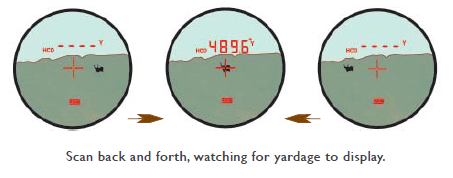
Scan back and forth, watching for yardage to display.
RANGEFINDING TIPS
Laser rangefinders work by emitting a brief pulse of light aimed at a target object. Distance is determined by the amount of time taken for the light to emit and return to the laser’s internal receiver. A laser’s ability to read range can be affected by many things—mostly relating to the target objects. Under ideal conditions, the Ranger can be expected to range a large reflective object out to 1000 yards and deer-sized game out to 500 yards.
Laser Performance Tips
- Light colors will usually reflect the laser pulse better than dark ones. An exception would be snow, which can be difficult to range.
- Shiny, reflective surfaces will usually reflect the laser pulse better than dull, textured surfaces. Animal hair will not reflect as well as a hard surface.
- Ranging while under cloud cover can improve laser performance compared to ranging while under bright sunny conditions.
- Solid objects, such as rock piles, will reflect the laser pulse better than less dense items such as bushes.
- Flat surfaces perpendicular to the laser pulse will reflect better than curved surfaces or surfaces angled in relation to laser pulse.
- Ranging over water can sometimes cause false reflections and readings.
- At longer distances, larger objects will be easier to range than small objects.
- The Ranger 1000’s laser pulse is emitted in an oval pattern which is oriented vertically. If you are having trouble ranging an object which is more wide than tall, try rotating Ranger 90 degrees and range again.
- If you are having difficulty ranging an animal or object, try ranging a different nearby object or use the Scan feature to pan back and forth while watching for changes in range number.
Tripod Use for Ranging
Using a tripod to steady the rangefinder can increase your ability to range small targets at longer distances. If the Ranger 1000 is used on a tripod, the reticle may appear tilted—depending on tripod level.
SAFETY AND PRECAUTIONS
Do not stare into beam or view directly without laser eye protection. Staring continuously into beam for prolonged periods of time could cause harm to your eyes. If used properly, this device is safe for your eyes and laser eye protection is not needed.
- Do not look at sun.
- Do not activate Menu or Measure buttons while aiming at eye or looking into objective lens.
- Use the correct battery (CR2) and proper battery orientation.
- Do not disassemble.
- Do not allow children to play with unit.
MAINTENANCE
- Use lens brush to remove dust or grit from lenses.
- Use a clean lens cloth or tissue to remove smudges or smears from lenses.
- Store rangefinder in a dry location away from direct sunlight.
RANGER 1000 SPECIFICATIONS
- Range Reflective: 11–1000 yards (10–914 meters)
- Range Deer: 11–500 yards (10–457 meters)
- Accuracy: + /- 3 yards @ 1000 yards
- Maximum Angle Reading: +/- 60 degrees (INC 50)
- Measuring Time: 1 second
- Battery Life: 2000 single range minimum
- Magnification: 6x
- Objective Lens: 22 mm
- Eye Relief: 17 mm
- Diopter: +/- 3 diopters
VORTEX OPTICS WARRANTY
Vortex Optics offers a lifetime limited warranty against manufacturer defects in materials and workmanship for the life of the product. Rest assured, if your Ranger 1000 rangefinder should ever require repair, all you need do is contact Vortex for service.
Call Vortex Optics at 800-426-0048 or e-mail service@vortexoptics.com
Vortex Optics
2120 West Greenview Drive
Middleton, WI 53562
service@vortexoptics.com
Visit vortexoptics.com for more information. Canadian customers may visit vortexcanada.net for customer service information.
For more manuals by Vortex visit, ManualsLibraryy
Vortex Ranger 1000 Rangefinder-FAQs
What battery does a Vortex Rangefinder take?
The Vortex Ranger 1000 uses a CR2 battery. It’s long-lasting, easy to find, and covered under the VIP Warranty.
Does the Vortex Ranger 1000 have angle compensation?
Yes, it uses HCD (Horizontal Component Distance) mode to provide angle-compensated range information for rifle and bow shooters.
Can you use a Vortex rangefinder for golf?
Yes, the Vortex rangefinder delivers accurate ranges to help improve your game and hit more greens.
What is HCD mode on a Vortex rangefinder?
HCD Mode shows angle-compensated distance, ideal for archers, mountain hunters, and precision shooters.
How long does a Vortex battery last?
Battery life is up to 300 hours on the highest setting and up to 5,000 hours on the lowest setting.
What does HCD mean on a rangefinder?
HCD stands for Horizontal Component Distance. It provides a corrected yardage reading, factoring in the shot angle.
How much air pressure is required for a Polaris Ranger 1000?
Front tires: 10 psi (69 kPa); Rear tires: 14 psi (96.5 kPa). For RANGER CREW models, front tires need 16 psi (110 kPa) and rear tires need 20 psi (138 kPa).
Can you use a rangefinder as a spotting scope?
Rangefinders are primarily for measuring distances but can also help spot game visible to the naked eye.
What’s the difference between HCD and LOS?
HCD gives angle-compensated distances. LOS (Line of Sight) shows straight-line distances without angle adjustment.
What voltage does a Vortex battery require?
The Vortex rangefinder needs 45-50V DC input voltage for proper operation when on battery power.
Does Vortex offer a lifetime warranty?
Yes, Vortex offers a VIP Lifetime Warranty. If you ever have an issue, they will repair or replace your product.
What is speed mode on a rangefinder?
Speed Mode provides yardage for moving targets and includes slope and angle calculations.

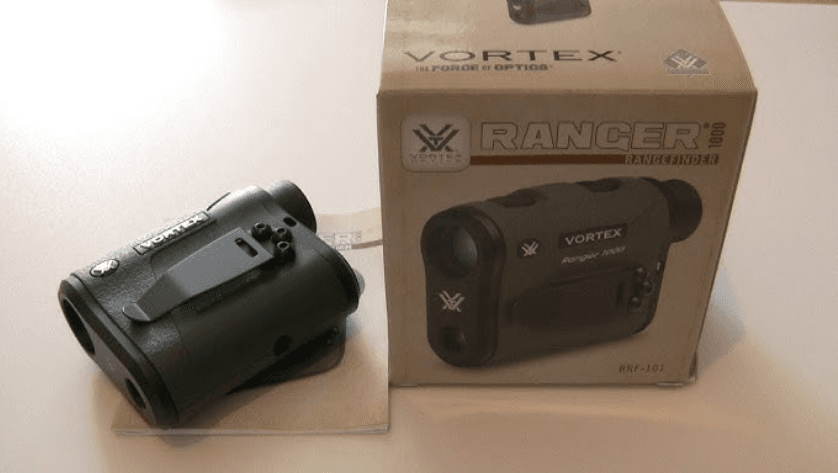
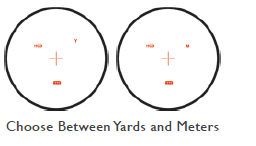 Set and Save Mode Selections in 3 Steps
Set and Save Mode Selections in 3 Steps